Brisket is considered the best of all the BBQ options. But it’s not cheap, so you don’t want to over-order and end up with way too much. So when you’re budgeting for your next gathering, how much is brisket per pound?
As a general rule, expect to pay between $4-6 per pound for uncooked brisket. Brisket that has been trimmed of excess fat will be more per pound. Also, expect to pay more for USDA Prime or Wagyu.
And how much is ideal per person?
We’ll find out about brisket, how much it’s sold for at Costco and Sam’s, and whether it’s worth it to buy Prime-grade brisket. But we’ll actually look at real-world prices for all types of brisket and look at several cost-saving hacks you can use to save a lot on your next brisket!
Let’s get into it.
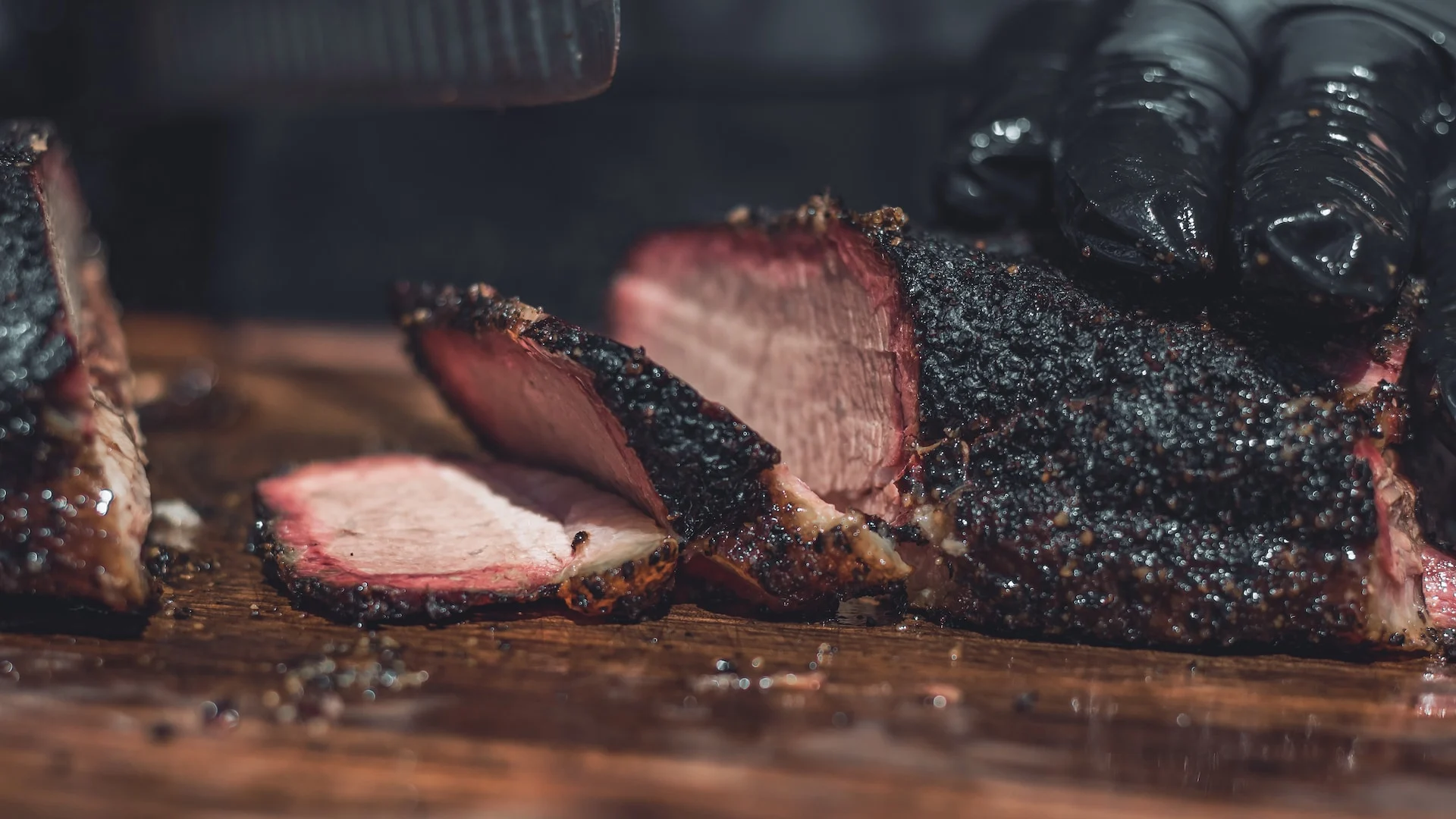
Why Choose Brisket?
Brisket, a staple in BBQ culture, stands out for its rich, savory flavor derived from its fat and collagen. It’s not just about taste; the slow-cooking process of brisket is a satisfying experience, embraced as a tradition by BBQ enthusiasts. Brisket prices vary based on quality and preparation, influenced by marbling and cut.
For cost-conscious shoppers, warehouse clubs like Costco offer brisket at reasonable rates, though not all cheap options guarantee flavor and tenderness. Local butchers provide a range of cuts, often with helpful advice and occasional discounts. The cost is also dependent on weight, making size selection important to avoid leftovers or shortages.
Beyond the initial purchase, brisket’s value extends to the cooking experience and the joy of sharing succulent, flavorful meat. While factors like cost and availability influence buying decisions, the satisfaction of preparing and enjoying a quality brisket makes it a worthy investment for BBQ lovers. With these insights, choosing the right brisket becomes a less daunting task.
How Much Is Brisket? – Pro Tips
Generally, brisket prices can range from around $3 to $8 per pound for a choice grade brisket at a supermarket. However, for prime grade brisket, often sought after for its higher marbling and flavor, prices can range from $5 to $12 per pound.
The price range of $3 to $8 per pound for choice brisket at grocery stores can be attributed to several factors:
- Regional Variations: The cost of living and local demand for brisket differ across regions, influencing its price. In areas where brisket is a staple in local cuisine, such as in the Southern United States, it might be priced more competitively. Conversely, in regions where brisket is less popular, prices can be higher due to lower turnover and higher transportation costs.
- Supply and Demand: Fluctuations in supply and demand significantly impact brisket prices. For instance, during peak barbecue seasons, such as summer and major holidays like the 4th of July, demand for brisket increases, often driving up prices. Off-season, prices may drop due to lower demand.
- Grocery Store Pricing Strategies: Individual grocery stores have different pricing strategies. Some may offer brisket at lower prices as a loss leader to draw customers in, while others might price it higher as part of a premium product range. Large chain stores often have more competitive pricing compared to smaller, independent stores.
- Quality Variations within the Choice Grade: Even within the USDA’s choice grade, there can be variations in quality. Brisket with higher marbling (intramuscular fat) within the choice category might be priced higher due to its superior flavor and tenderness compared to a leaner choice brisket.
- Market Conditions and Cost Fluctuations: The price of beef, including brisket, is subject to fluctuations in the agricultural market, affected by factors like feed costs, cattle supply, and even international trade conditions. These broader market dynamics can cause variations in brisket prices at the retail level.
At warehouse clubs like Costco or Sam’s Club, brisket can be more economical, especially when bought in bulk.
Here, you might find prices slightly lower than average supermarkets, hovering around the lower end of the price spectrum. Butcher shops and specialty meat markets, known for premium quality, often price brisket higher, especially for grass-fed or organic varieties.
These can cost upwards of $10 per pound, and for Wagyu brisket, known for exceptional marbling and quality, prices can soar to $20 per pound or more.
Seasonality and regional factors also play a role in brisket pricing. In areas where barbecue is more popular, such as the Southern United States, brisket may be more competitively priced. During barbecue season, typically in the summer months, prices may rise due to increased demand.
Let’s examine all the different options and prices for raw, uncooked brisket:
- USDA Select Whole Packer Brisket – $3.00/lb
- USDA Choice Whole Packer Brisket – $4.00/lb
- Trimmed Flat Brisket – $5.00/lb.
- Trimmed Point Brisket – $6.00/lb.
- USDA Prime Whole Packer Brisket – $4.50/lb
- Grass-Fed Whole Packer Brisket – $5.50/lb
- Wagyu Prime Whole Packer Brisket – $8.25/lb.
But the price of brisket changes with the season. For example, during summer, when it’s barbecue season, expect a higher price.
Brisket cost may go up by about $0.50 because of increased demand. Interestingly, this is also the time stores usually offer sales. The price could drop below $2, especially at places like Walmart.
Of course, where you are in the country will also impact prices.
Whole-packer brisket tends to cost less than flat-cut brisket, which is sold separately. This is because any part that leads to waste usually attracts higher prices.
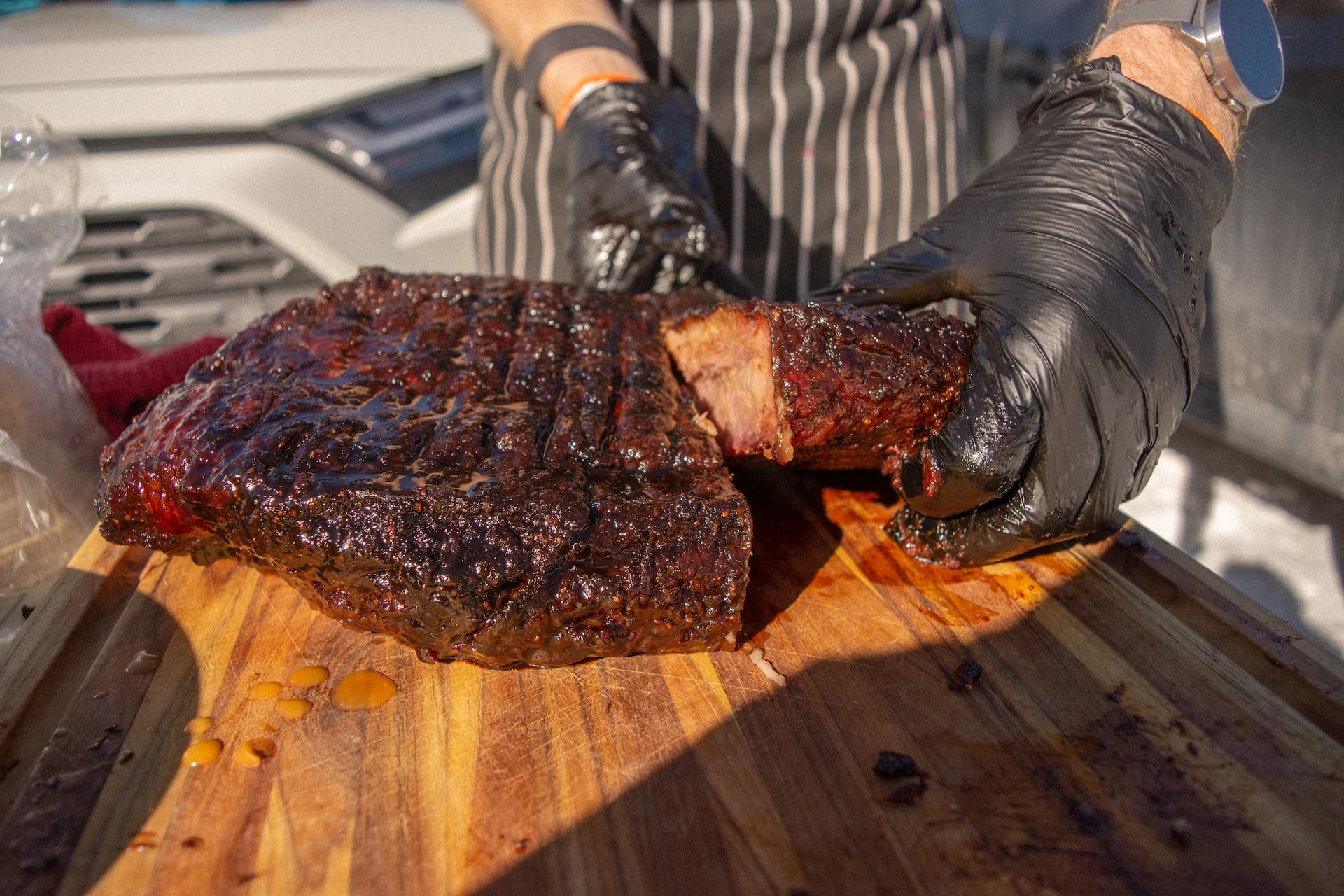
How to Find Affordable Brisket
Finding affordable brisket is easier than you might think, especially if you explore warehouse clubs like Costco or Sam’s Club. These clubs often have high-quality brisket at competitive prices, but remember you’re buying in bulk, so ensure ample freezer space or friends to share with. For barbecue enthusiasts, brisket is a coveted choice, yet its price can be daunting. The key to affordability is watching for sales and discounts, particularly around major grilling holidays.
Local butchers are also great for finding brisket at reasonable prices. They offer a range of cuts and can provide insights into the quality and marbling of the meat. Additionally, online meat markets have become a viable option, offering competitive prices on quality brisket with detailed descriptions and photos.
Whether you’re opting for warehouse deals, waiting for sales, or visiting local butchers, being informed and flexible in your shopping approach is essential for finding brisket without breaking the bank. With these strategies, you can enjoy delicious brisket at a value that suits your budget.
1. Join a Warehouse Club – Sam’s or Costco
Joining a warehouse club like Costco or Sam’s Club can lead to significant savings on brisket.
These clubs often offer high-quality brisket at prices lower than supermarkets or local butchers due to their bulk buying, passing savings to customers. This approach is ideal for frequent barbecue hosts or brisket enthusiasts looking for economical purchases.
Warehouse clubs provide various brisket cuts, with clear labeling on packaging, aiding customers in selecting the right cut for their cooking needs, be it slow-roasted dinners or smoked BBQ.
Additionally, these clubs often run sales and discounts, further reducing the average cost of brisket. Joining a warehouse club can be a savvy move for maximizing brisket value, offering affordability without compromising quality. While shopping, consider factors like quality grade and cut to ensure the best value.
As of the time of writing, Costco and Sam’s brisket goes for $5.49 per pound for Choice whole brisket and $11.99 for Prime flat-cut brisket.
The following is usually what’s on offer at Costco:
- USDA Choice Commodity Beef Brisket with 18 lb weight on average
- USDA Choice Beef Brisket Flat with 8 lb weight on average
- USDA Prime Commodity Beef Brisket with 14 lb weight on average
2. Check Out Your Local Butcher
For high-quality brisket at great prices, your local butcher is an invaluable resource.
They offer not only affordable options but also expert advice on brisket cuts and selection. Local butchers understand the nuances of different cuts, helping you choose the right one for your culinary needs, whether it’s finding well-marbled brisket or the best cut for a barbecue.
Local butchers often provide sales and discounts competitive with larger stores, benefiting from bulk purchases from trusted suppliers. While warehouse club deals are attractive, local butchers might outdo them, especially when considering membership fees. Shopping at a local butcher also supports small businesses.
Building a relationship with your local butcher can lead to insights on economical brisket purchases, like buying in bulk during sales or choosing less popular cuts that offer similar flavors at lower prices.
They provide quality assurance, ensuring you get value for your purchase. Local butchers can guide you in selecting and cooking brisket, making them a valuable ally for any barbecue plan. Quality and value are paramount, and a local butcher can ensure you get the best of both.
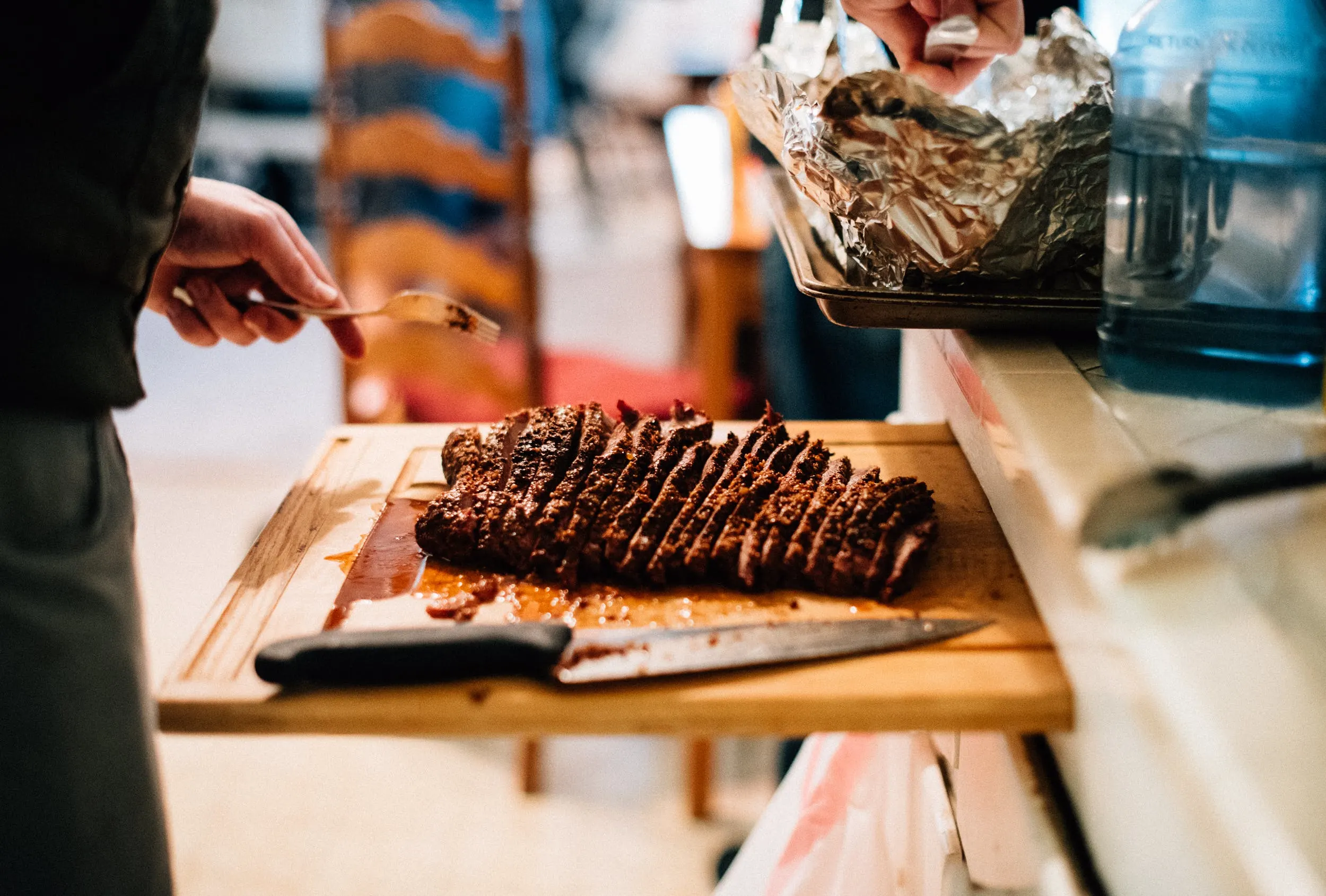
3. Wait for Sales
Brisket prices fluctuate throughout the year. As a savvy shopper, watch for sales and discounts at retail stores, especially during big barbecue holidays like July 4th and Labor Day. This is when stores often reduce brisket prices to attract customers.
Seasonal sales are key, but knowing where to find these deals is crucial. It’s a myth that only local butchers or specialty shops offer sales. Wholesale retailers like Costco and Sam’s Club frequently provide brisket deals due to their bulk purchasing power, offering significant savings.
When evaluating sale prices, assess the quality of the brisket. Look for marbling, as it indicates tenderness and flavor. For large gatherings, consider purchasing a whole packer brisket for cost-effectiveness.
Ultimately, whether brisket is worth the price depends on your budget, occasion, and taste preferences. Quality brisket, even at a higher cost, offers the satisfaction of a delicious, home-cooked meal.
4. Buy a Whole Side of Beef
Buying a whole side of beef, while seemingly excessive, can be an economical strategy for brisket lovers. This bulk purchase offers a constant supply of high-quality brisket and other beef cuts, allowing for a variety of home-cooked meals. It’s like having your own wholesale source, with substantial savings on high-quality cuts.
This approach requires ample freezer space and possibly vacuum-sealing equipment for long-term storage. Considerations like transport and processing fees also play into the cost-effectiveness. However, with careful planning and an eye on market trends, buying in bulk can lead to significant savings and quality control over your meals.
If feasible, buying a whole side of beef can be a surprisingly efficient option, offering both financial benefits and a satisfying stock of meat at home.
Factors Influencing Brisket Prices
Brisket pricing is influenced by various factors, including meat quality, purchase location, and market trends.
Higher-grade brisket with good marbling usually costs more, as do organic and grass-fed varieties. Wholesale clubs like Sam’s Club and Costco often offer brisket at lower prices due to bulk buying, making them good options for affordable purchases.
Supply and demand in the beef industry also impact brisket prices, with costs typically rising during BBQ season. The cut size and type, such as whole packer brisket, also affect the price, as does the preparation process.
Whether brisket is worth its price depends on personal preference.
For enthusiasts who relish tender, smoked meats, investing in quality brisket and learning cooking techniques can result in an exceptional meal. However, for those with varied meat preferences, waiting for sales or exploring other cuts might be more cost-effective. In the end, it’s about individual taste and the value placed on brisket’s unique flavor.
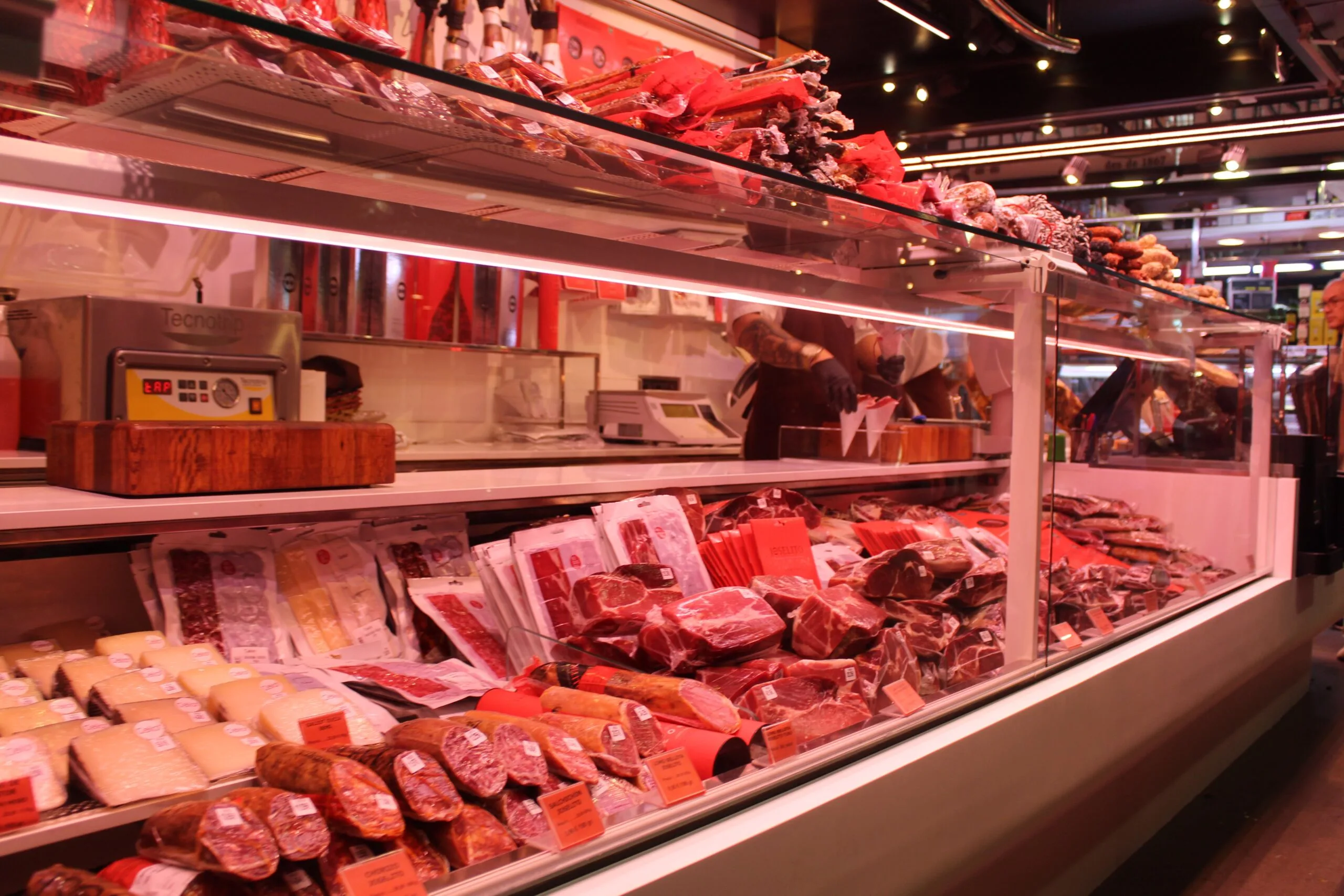
Picking Out Your Brisket
Choosing the right brisket involves several key decisions. For home-cooked family dinners, a flat cut, which is leaner and uniformly thick, is ideal. For larger outdoor gatherings, opt for a packer or whole brisket, which is bigger in size. When it comes to quantity, buy enough to suit your needs, considering the size of the gathering to ensure cost-effectiveness.
Quality-wise, look for brisket with consistent marbling, as it enhances flavor and texture. The brisket’s shape is also important; an evenly thick piece cooks more uniformly.
To save on costs, keep an eye out for sales and discounts. Warehouse stores like Costco often offer brisket at lower prices, especially when buying in bulk. Local butchers might have special deals or member discounts that can also help you save.
Let’s look at a few specifics!
Step 1: Choose Your Cut
Selecting the right brisket cut is crucial.
At your local butcher or supermarket, you’ll find two main types: the flat cut and the point cut. The flat cut is leaner, consistently thick, and perfect for uniform slices, making it ideal for sandwiches or plated dinners. It’s generally pricier due to its popularity. The point cut, or “deckle,” is fattier and imparts rich flavor, especially when cooked properly. It’s excellent for making burnt ends, a BBQ favorite.
Your choice depends on your cooking goals and preference for lean meat versus flavorful, fatty cuts.
Marbling, the thin fat threads in the meat, also plays a significant role in brisket’s juiciness and taste. It melts during cooking, enhancing the brisket’s richness. When shopping, consider the marbling and choose based on your taste for leanness or flavor.
Ask your butcher about marbling to ensure you get a piece that meets your culinary needs.
Step 2: Decide on Your Size
Selecting the right brisket size is crucial. For small family dinners, a brisket weighing 4-6 pounds is adequate. For larger gatherings, opt for bigger cuts, considering brisket shrinks by up to 40% during cooking.
Quality is also important, especially marbling, which ensures flavor and juiciness. Warehouse clubs like Costco and Sam’s Club are good for value and quality. Local butcher shops offer high-quality, locally sourced meats and might provide savings through sales or discounts.
Brisket prices fluctuate, so keep an eye on market trends. With the right strategies, brisket can be a cost-effective, delicious choice for any meal size.
Step 3: Go for Quality
Quality is crucial when shopping for brisket, even with cost considerations. High-grade cuts yield a more tender texture and richer flavor, essential for a satisfying meal. Opting for cheaper brisket might sacrifice these qualities.
Investing in better cuts from your local butcher enhances the end result, as butchers can guide you to the best options and offer cooking tips. When considering bulk purchases from warehouse clubs like Costco, prioritize quality. Check reviews and try smaller quantities first. Pay attention to marbling, as it significantly contributes to tenderness and flavor, especially in low-and-slow cooking.
Remember, the price of brisket often reflects its taste value. Despite various cost-saving strategies, don’t compromise on quality for the best culinary experience.
Step 4: Check for Marbling and Shape
Marbling and shape significantly impact brisket quality. Marbling, the fat within the meat, enhances juiciness and tenderness when cooked. However, too much fat can lead to wastage, while too little might result in dryness.
Shape matters for even cooking. Ideally, a brisket should have uniform thickness to avoid uneven cooking, with thinner ends possibly overcooking before thicker parts are done. A balanced, evenly shaped brisket ensures a better cooking outcome.
Local butchers can provide valuable advice on selecting cuts based on your intended cooking method, like smoking or barbecuing. Warehouse clubs like Costco and Sam’s Club are also good for economical bulk purchases.
Buying whole beef and freezing portions for later can be cost-effective in the long run. By focusing on marbling, shape, and size, you can balance quality and cost when buying brisket.
Not sure how to pick a good brisket?
Interestingly, this is the theme of a recent article I published. In it, I shared riveting info about brisket, such as what a good brisket looks like, which cut is the best, and whether Prime or Choice brisket is better.
Just click the link to read it on my site.
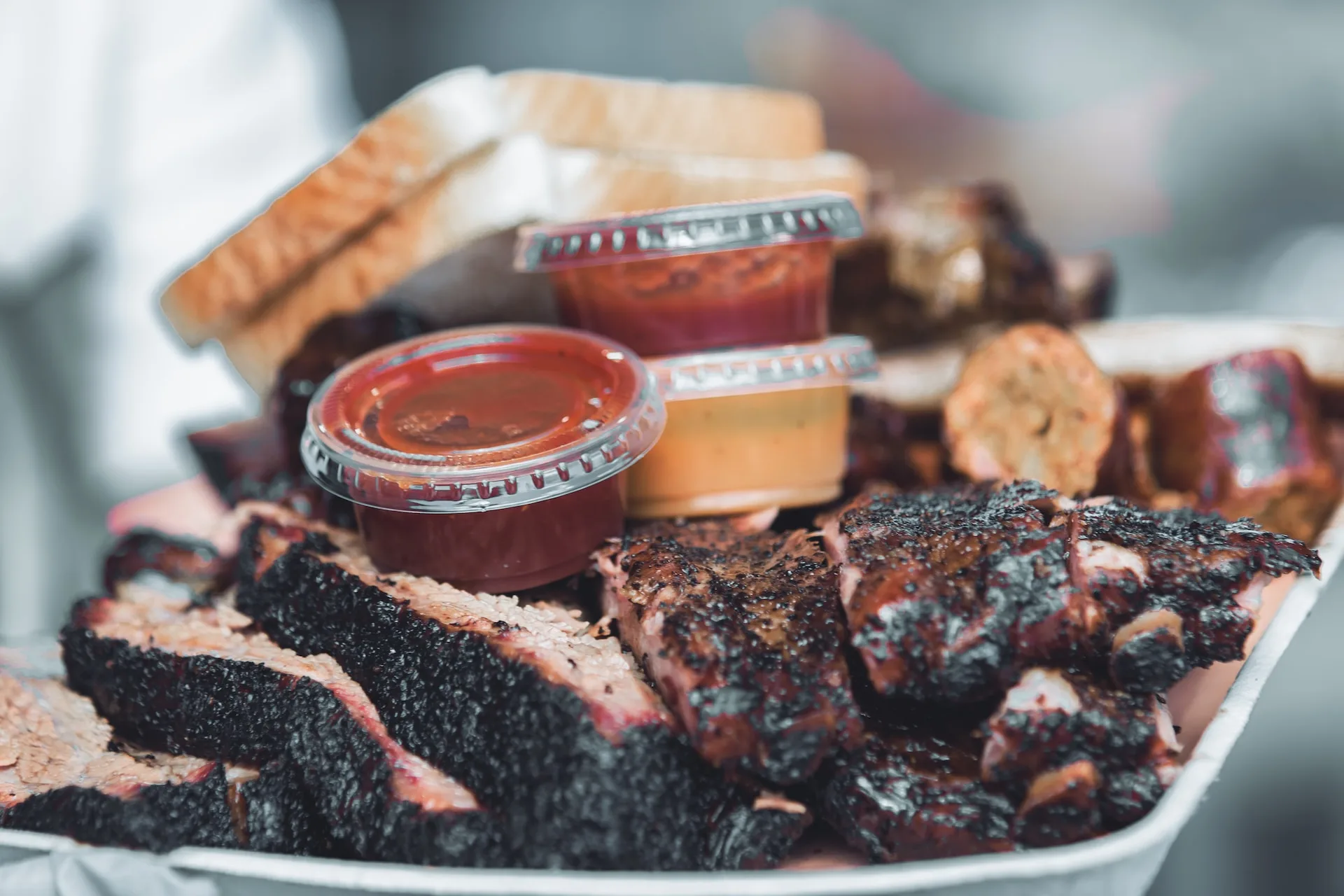
How much brisket per person should you serve?
A general rule of thumb is to plan to serve each person about ½ a pound of smoked brisket.
For young people or small children, ¼ or ¾ per person may be ideal. But it’s okay to plan to serve ½ a pound per person.
You might be wondering if it’s a good thing to buy much raw brisket. Based on the potential loss, it’s better to buy a larger brisket, so that you’re sure you can accommodate everybody.
As you know, briskets require a long cooking time. So, it’s not something you can quickly whip up in case you need more. If you’ll prepare it yourself, it’s best to buy a pound of brisket per person because, as we learned earlier, you’ll lose about ½. So, plan to buy 1 pound of raw brisket per person.
Now, if you’ve ever wondered how to make steak tender, check out a recent article on my site.
In it, I shared what makes a good tenderizer, why your steak is tough and chewy, and whether cooking beef longer makes it tender, and I also offered 11 simple tips to make the meat tender.
Just click the link to read it on my site.
Cooking Brisket at Home
Cooking brisket at home is a rewarding experience for any meat lover. The key to a perfect brisket lies in slow and low cooking, which tenderizes the tough cut and enhances its flavor. Begin by selecting a well-marbled brisket for juiciness.
Rubbing the brisket with a mix of spices like salt, pepper, garlic powder, and paprika, and allowing it to marinate overnight, will enhance its taste.
For cooking, preheat your oven or smoker to 225°F. If using an oven, place the brisket fat-side up in a roasting pan, cover it with foil, and cook for about 1 hour per pound. In a smoker, maintain a consistent temperature, adding wood chips for smoke flavor, and cook for the same duration.
A crucial step is to monitor the internal temperature of the brisket, aiming for 190-200°F for optimal tenderness. Once done, let it rest for 30 minutes to an hour before slicing against the grain to serve.
Basting the brisket during cooking can keep it moist, and wrapping it in foil halfway through can prevent excessive drying. Cooking brisket at home requires patience but results in a flavorful, tender dish that’s ideal for gatherings or a special family meal.
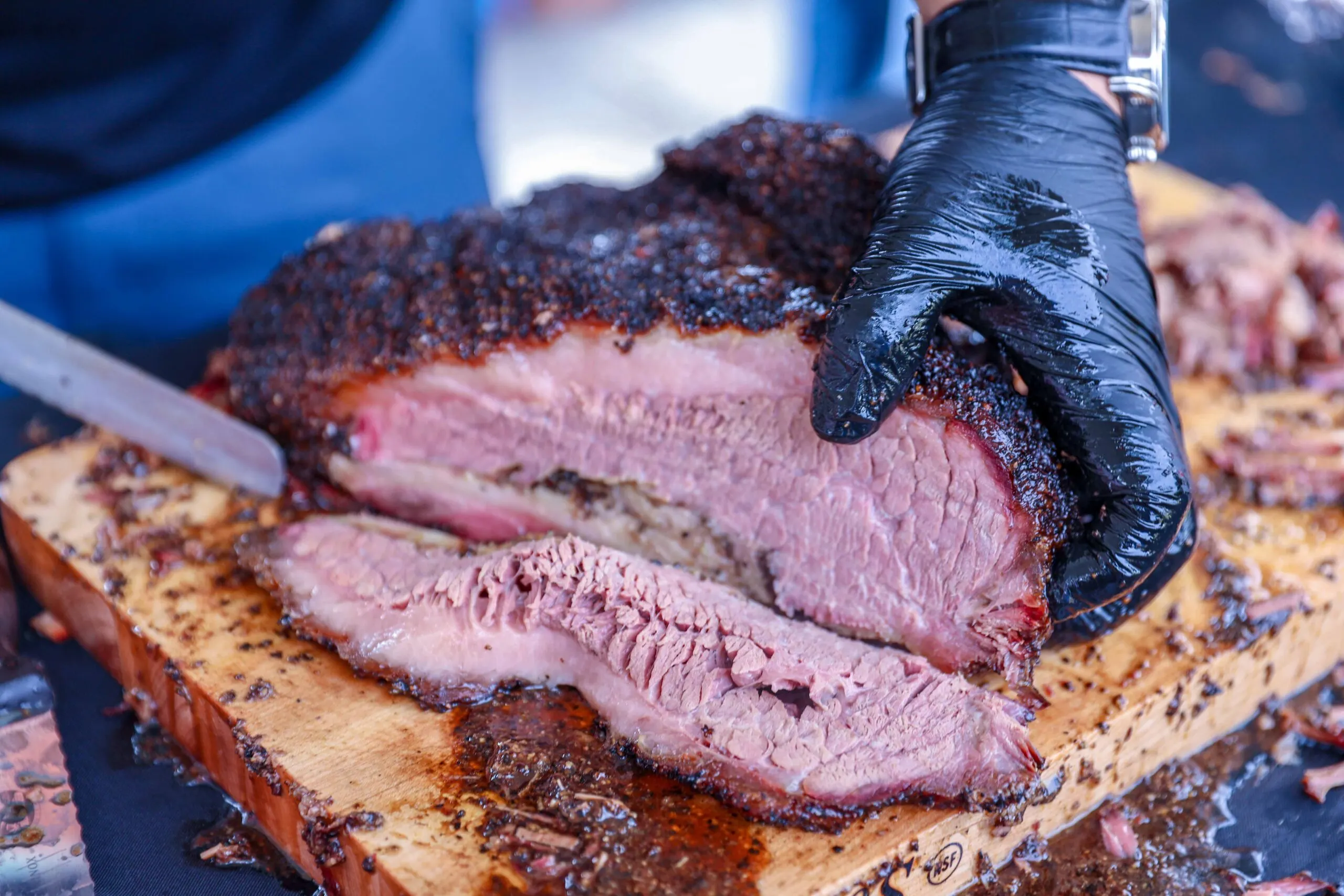
Is Brisket Worth the Cost?
Yes, brisket is worth the cost for those who appreciate its unique qualities.
Brisket, known for its rich flavor and tender texture when cooked correctly, offers a distinct culinary experience. Its higher cost compared to other cuts of beef is due to its large size, the longer time it takes to raise the cattle, and the cooking process it requires.
The value of brisket lies in its versatility in various cooking methods, particularly slow-cooking techniques like smoking or braising, which bring out its depth of flavor. It’s a popular choice for barbecues and family gatherings, providing a substantial meal that serves many people.
For barbecue enthusiasts and meat lovers, the cost is justified by the end result – a flavorful, succulent dish that’s often the centerpiece of a meal. The satisfaction derived from successfully cooking a challenging cut like brisket also adds to its worth.
While the price may be higher than other meats, brisket’s unique taste and texture, coupled with the enjoyment it brings to culinary experiences, make it a worthwhile investment for those who prioritize quality and flavor in their meat choices.
Conclusion
In conclusion, the cost of brisket per pound varies significantly based on factors such as cut, quality, and regional pricing trends.
Generally, the price of brisket can range from as low as $3 per pound for a basic flat cut to upwards of $22 per pound for high-quality, Wagyu-style briskets. The choice between flat cut and point cut also plays a role in pricing, with point cuts often being slightly more expensive due to their higher fat content and richer flavor.
Geographical location and seasonality influence brisket prices too. In regions where barbecue is popular, brisket may be more competitively priced, especially during peak grilling seasons like summer and national holidays. Additionally, wholesale purchases from club stores like Costco or Sam’s Club can offer brisket at lower prices, though it typically requires buying in bulk.
For budget-conscious consumers, monitoring local sales and exploring local butchers or farmers’ markets can lead to finding brisket at more affordable rates. Upscale grocery stores or specialty meat shops tend to price brisket higher, reflecting the premium quality or specific breed of the cattle.
Ultimately, the price of brisket per pound is subject to a variety of influences, from the type of cut and quality to the location and season. While brisket can be a pricier meat option, its rich flavor and versatility in cooking make it a worthwhile purchase for many meat enthusiasts and barbecue aficionados.
Frequently Asked Questions
Can You Freeze a Brisket for Later?
Yes, you can freeze a brisket for later use.
Freezing brisket is an effective way to preserve its quality, extending its shelf life significantly. To properly freeze brisket, first ensure it’s cooled down if it has been cooked. For raw brisket, wrap it tightly in heavy-duty aluminum foil or plastic wrap, and then place it in a freezer bag to prevent freezer burn. Removing as much air as possible from the bag helps maintain its quality.
Frozen raw brisket can last for up to 12 months in the freezer without significant loss of flavor or texture.
Cooked brisket can also be frozen following the same wrapping method and will last for 2-3 months in the freezer. When you’re ready to use the frozen brisket, thaw it in the refrigerator for 24-48 hours before cooking or reheating. It’s important not to thaw brisket at room temperature, as this can lead to bacterial growth.
Freezing doesn’t significantly alter the taste or texture of brisket, making it a practical option for managing larger cuts or taking advantage of sales. This method is ideal for ensuring you always have brisket on hand for future meals.
Do you save money buying a pre-trimmed brisket?
The price differential between trimmed and untrimmed brisket is negligible. So, you’re not saving something substantial either way.
If you know how to trim brisket very well, you may want to do it yourself. Otherwise, you’ll probably be better off buying one that’s pre-trimmed. At least, you’ll save yourself time and won’t run the risk of trimming it too much.
Trimming brisket yourself can be tricky as there’s a need to find a sweet spot between leaving too much fat and eventually eating something a tad rubbery or cutting off too much fat and ending up with an overly dry brisket!
Is Wagyu brisket worth the extra cost?
Yes, Wagyu brisket is worth the extra cost. It is highly marbled, which counteracts the drying of the meat while it’s being smoked. It’s also graded Prime by the USDA.
Wagyu is originally Japanese, so the grading system is a little bit different from what’s used by the USDA.
When it’s graded BMS 9, it’s a step higher than Prime, quality-wise.
It’s known for its intense flavor, fat, and tenderness. And it contains omega-3 fatty acids, which are good for the heart. The below depicts how Japanese Wagyu is classified.
- Japanese Black
- Japanese Brown
- Japanese Polled (not bred outside of Japan)
- Japanese Shorthorn (not bred outside of Japan)
Japanese Wagyu is not currently being imported. What we have were imported in the 80s and 90s. Only a few ranches breed 100 percent Japanese Wagyu. So, American Wagyu is a breed of the former American Angus or Hereford.
Snake River Farms offer the best quality Wagyu in the states.
They carefully manage their cattle in a manner that brings them pretty close in quality to their Japanese ancestors. They offer two grades of Wagyu: premium Gold Grade that has a BMS of 9+ and Black Grade.
Because Wagyu is highly marbled, you’ll need to trim it and also be patient when preparing it, as it will take a long time to render the fat down.
It’s believed to be the “secret weapon” of Myron Mixon, a 4-time World Barbecue Champion. Some seasoned smokers believe that Wagyu is the best brisket one can buy.
Ready to smoke a perfect brisket every time?
Check out this recent article on my other website that walks you through the brisket smoking process step-by-step. Just click that link to read it on my site.
Is Prime brisket worth the extra cost?
Yes, Prime brisket is worth the extra cost. It’s tender, flavorful, and juicier. It takes less time to prepare to boot. It’s ideal if you want great brisket.
As you know, Prime is the highest when we consider beef grades.
Beef is graded based on the degree of intramuscular fat and the age of the carcass when it was slaughtered. It’s no accident that Prime is number one on the list seeing as it’s produced from young, well-fed cattle.
It’s highly marbled, making it tender and flavorful. You can make good brisket with Choice, but if you want to take it up a notch, prime cuts are the way to go.
You’ve probably wondered how grocery stores keep meat fresh.
You have, right? Find out in a recent article I published, where I shared how long grocery stores keep meat and how butchers keep meat fresh.
Just click the link to read it on my site.
How much is already smoked brisket per pound at restaurants?
You will find already smoked brisket per pound going for about $25 to $35 at a barbecue restaurant.
But it can be higher in some barbecue joints! It turns out that the days when we saw brisket as one of the cheapest cuts of meat are probably over.
It’s very expensive! Yes, it is.
In a previous section, we’ve already explored why the price of raw briskets has soared in recent times. As you know, restaurants incur additional expenses to prepare smoked briskets. And they also have indirect overheads.
While seafood or pasta dishes take some minutes to prepare, smoked briskets take a lot of time. In some cases, they take over 10 hours to be ready! A lot goes into preparing smoked briskets.
Now, you can understand why it’s joined the rank of expensive meats.
In the past, the brisket wasn’t one of the beloved parts of a steer. It was often used for ground beef. Now, it’s enjoyed with a selection of savory side dishes.
- Crescent Roll Origins: Which Country Created It? - February 21, 2024
- What is the Origin of the Name Crescent Rolls? - February 21, 2024
- Are Pillsbury Crescent Rolls a Good Substitute for Puff Pastry? - February 21, 2024
